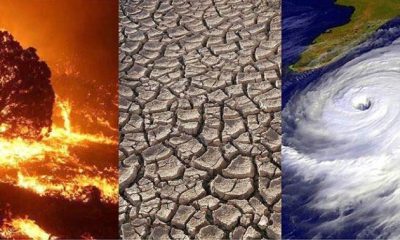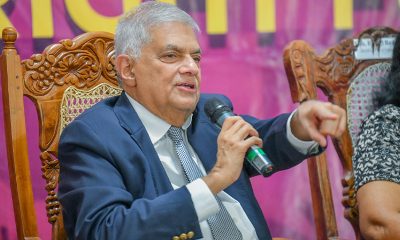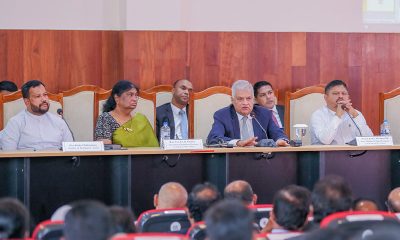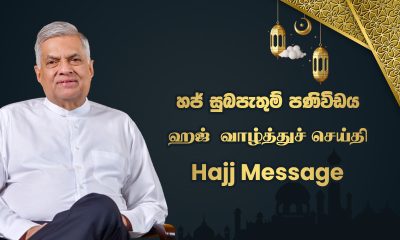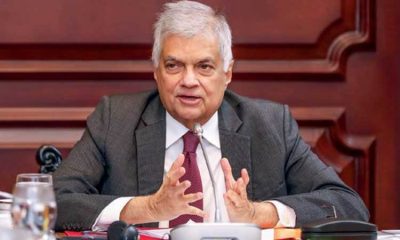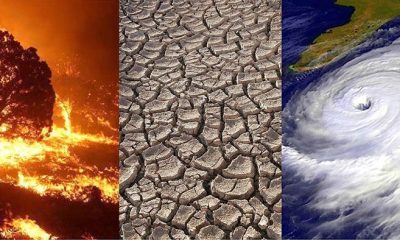News
President promises Rs 1 bn for research on Buddha’s teachings and Artificial Intelligence

President Ranil Wickremesinghe has assured that one billion rupees would be allocated next year for research on the Buddha’s teachings and Artificial Intelligence.The President disclosed that the project was previously scheduled to commence this year but had to be postponed due to the absence of required legislation for the regulation of AI. The President said that the project could get underway once the parliament adopted the new laws.
President Wickremesinghe said so at the 100th anniversary celebration of the Sri Lanka Buddhist Society Moratuwa, held Saturday (11) at the Moratuwa Buddhist Society Hall.
The Moratuwa Buddhist Society Hall, initiated under the Sri Lanka Buddhist Society Moratuwa, had its foundation stone laid in 1925. This society was established on May 11, 1924, under the leadership of Mr. Arthur V. Dias. The building was inaugurated as the Buddhist Headquarters for Buddhist population in Moratuwa on June 24, 1929, by the then Governor of British Ceylon Sir Herbert J. Stanley with officiating the opening ceremony. Additionally, on that same day, the foundation stone for Moratuwa College was also laid.
The President said that the government would finance the restoration of the Moratuwa Buddhist Society Hall, which is approaching its centenary.
The Vice President of Moratuwa Buddhist Society Dhammika Chandranath Fernando presented the centenary commemorative souvenir to President Wickremesinghe.
President Wickremesinghe, speaking at the event, added:
“Today, the world is confronted with a significant threat posed by climate change. The unprecedented intensity of sunlight we’re experiencing is unlike anything we’ve encountered before. We find ourselves in a challenging situation that requires focused efforts to mitigate climate warming. Additionally, we’re grappling with a substantial water scarcity issue. It’s essential to approach these challenges in alignment with the teachings of Buddha.
In the next two or three decades, climate change will emerge as one of the primary global challenges. According to Buddha’s teachings, this issue stems from civilization’s greed for rapid progress. The widespread desire for advancement has led to increased vehicle usage, resulting in significant environmental damage. Consequently, human society has inflicted considerable harm on the environment. Hence, it’s crucial to prioritize efforts to control climate change.
Today, the world is witnessing rapid technological advancements.
Despite initial beliefs after the atomic bomb explosion in 1945 that technological progress might cease, there has been significant advancement across all sectors. Particularly, the IT sector has seen remarkable progress. During our school days, computers and mobile phones were non-existent, but with modern technological advancements, we now have access to Artificial Intelligence.
We are currently at the dawn of Artificial Intelligence, prompting questions about its trajectory over the next two decades. It’s
essential to explore the relationship between artificial intelligence and Buddhism.
Buddha’s teachings emphasize the power of our minds in shaping our lives. By mastering our minds, we pave the way for progress; failure to do so leaves us with no future. This message was specifically intended for humanity, highlighting the importance of controlling our minds to overcome desires.
Now, artificial intelligence (AI) mirrors the capabilities of the
human mind. AI can process vast amounts of information and operate accordingly. Therefore, it’s pertinent to explore the connection between Buddha’s teachings and AI, considering their shared focus on the mind’s control and its implications for our actions.
If artificial intelligence promotes a different religion, it could pose a threat to Buddhism, so it’s crucial to consider this possibility. Throughout history, Buddhism in Sri Lanka has been influenced by Hinduism, Mahayana and political influences. With the emergence of artificial intelligence, it adds another layer of influence. Therefore, we must contemplate whether AI might propagate alternative doctrines.
It’s essential for people to contemplate the implications of integrating Dhamma with the mobile devices they use. This issue extends beyond Buddhism to other religions as well.
Hence, we are implementing new regulations to oversee artificial intelligence. The Ministry of Technology has drafted legislation for technology development, including plans to establish an artificial intelligence centre. Countries like the United Kingdom and the European Union have already enacted laws to govern artificial intelligence, and we must follow suit.”
Latest News
Advisory for severe lightning for the Western and Sabaragamuwa provinces and Galle and Matara districts
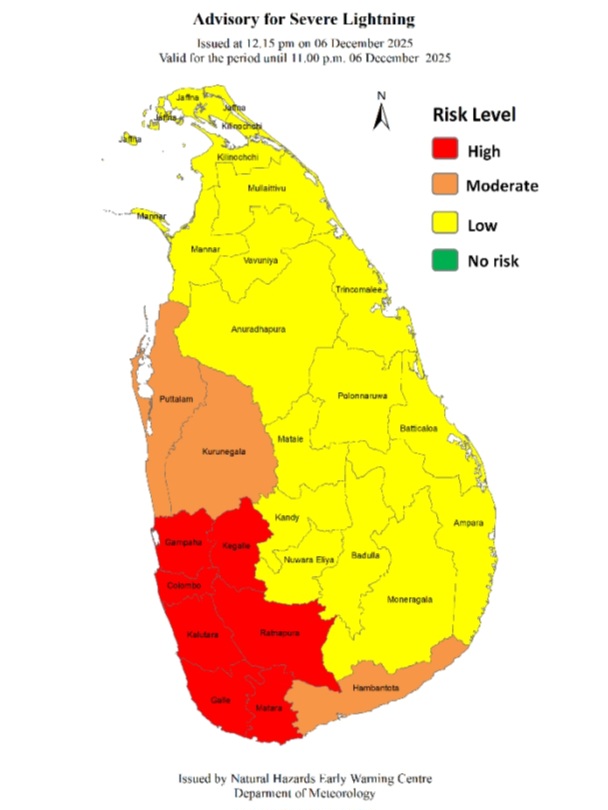
Advisory for Severe Lightning Issued by the Natural Hazards Early Warning Centre at 12.15 p.m. 06 December 2025 valid for the period until 11.00 p.m. 06 December 2025.
The public are being cautioned that thundershowers accompanied with severe lightning are likely to occur at some places in the Western and Sabaragamuwa provinces and in Galle and Matara districts.
There may be temporary localized strong winds during thundershowers.
The General public is kindly requested to take adequate precautions to minimize damages caused by lightning activity.
ACTION REQUIRED:
The Department of Meteorology advises that people should:
Seek shelter, preferably indoors and never under trees.
Avoid open areas such as paddy fields, tea plantations and open water bodies during thunderstorms.
Avoid using wired telephones and connected electric appliances during thunderstorms.
Avoid using open vehicles, such as bicycles, tractors and boats etc.
Beware of fallen trees and power lines.
For emergency assistance contact the local disaster management authorities.
News
Government briefs Diplomatic Community on recovery progress

A special briefing for the diplomatic community in Sri Lanka was held on 4 December at the Ministry of Foreign Affairs, Foreign Employment and Tourism, chaired by Prime Minister Dr. Harini Amarasuriya together with the Minister of Foreign Affairs, Foreign Employment and Tourism, Vijitha Herath. Senior government officials, including representatives of the Disaster Management Centre (DMC) and the Sri Lanka Tourism Development Authority (SLTDA), also participated.
Opening the session, Prime Minister Dr. Harini Amarasuriya expressed her gratitude to the diplomatic community for their immediate support and solidarity following the recent floods and landslides. She noted that Sri Lanka had endured one of the most severe disasters in recent years, but the resilience of the people and the coordinated efforts of government agencies had enabled a rapid response and significant progress in relief operations. She confirmed that not a single tourist has been reported harmed during the disaster and noted that the previously inaccessible areas are now reachable. Massive cleanup and decontamination operations are underway to ensure that lands and public spaces are safe for return, and communications have been restored in the affected areas.
The Prime Minister emphasized that relief, evacuation, and emergency assistance were carried out with the collective effort of the tri-forces, police, public officers, health workers, volunteers, and local authorities. She acknowledged the continuing challenges, including the restoration of infrastructure, resettlement needs, and long-term disaster-mitigation work, and welcomed the technical, humanitarian, and financial support offered by partner countries.
Maj. Gen. Sampath Kotuwegoda (Retd), Director General of the Disaster Management Centre, delivered a detailed presentation on the current status of the disaster, including the number of affected families, evacuation centres, damage assessments, and the ongoing coordination with international agencies for recovery planning. The cyclone affected almost the entire country, with 22 districts severely impacted. Some locations recorded up to 540 mm of rainfall and winds of up to 70 km/h, causing widespread infrastructure damage. Early assessments indicate that 2.3 million people were exposed to flooding, with 1.8 million people directly affected on the ground and 1.1 million hectares of land impacted. The assessment also identified 40,152 pregnant women among those affected, who have been prioritized for support. He also highlighted areas where further technical cooperation, such as early-warning systems, mapping capabilities, and climate-response technologies would be valuable.
Buddhika Hewawasam, Chairman of the Sri Lanka Tourism Development Authority, briefed the diplomatic community on the impact of the disaster on the tourism sector. He reassured attendees that major tourism zones remain operational, safety assessments are underway, and contingency measures have been activated to support visitors and protect the industry during the upcoming peak season. The Chairman of the Hotel Association of Sri Lanka Ashoka Hettigoda confirmed that the Coastal and resort hotels from Maravila to Passikudah are operating, with many reporting 60–65 percent occupancy; the hotels in Nuwara Eliya are partially operational. He made an appeal that the best assistance that the international community can give to Sri Lanka is the continued support provided through tourism.
Several diplomats conveyed their condolences to affected communities and reaffirmed their governments’ readiness to assist Sri Lanka in both immediate relief efforts and long-term rebuilding. They expressed appreciation for the government’s transparent engagement and the coordinated approach to managing the crisis.
Prime Minister thanked the diplomats for their continued cooperation and underscored the government’s commitment to ensuring an effective and inclusive recovery. She stressed that strengthening disaster preparedness, climate resilience, and institutional capacity will be central to Sri Lanka’s national development agenda moving forward. Deputy Minister of Foreign Affairs, Foreign Employment and Tourism, Arun Hemachandra, Secretary to the Prime Minister, Pradeep Saputhanthri, and Secretary to the Ministry of Foreign Affairs, Ms. Aruni Ranaraja, also attended the meeting.

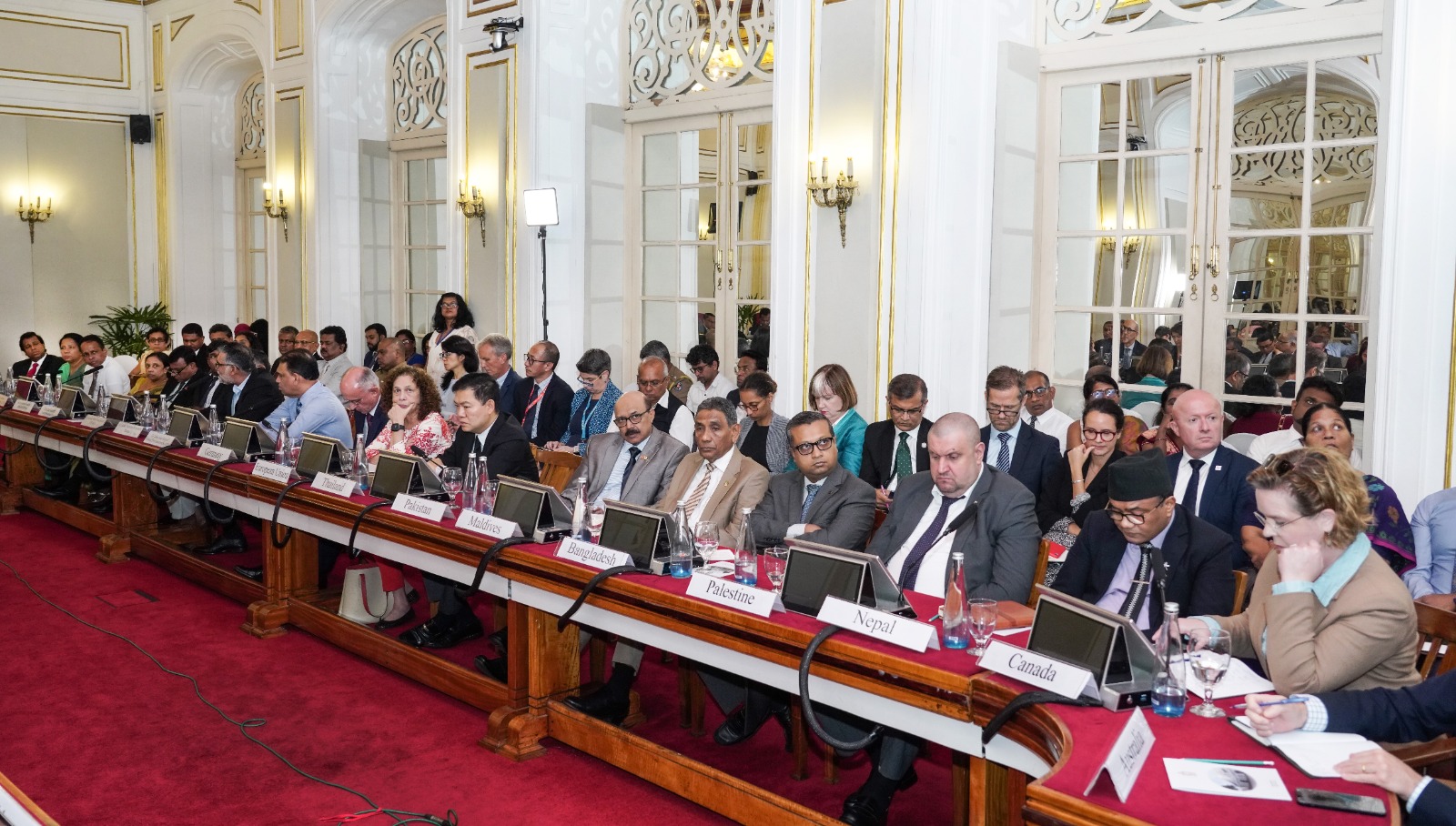
[Prime Minister’s Media Division]
News
All parties have agreed to recruit Development Officers into the teaching service through a competitive examination – PM

Addressing Parliament on Friday (05), the Prime Minister stated that, in accordance with the Supreme Court decision, the recommendations issued by the Public Service Commission, and the Sri Lanka Teachers’ Service Minute, all parties have agreed to recruit teachers through a competitive examination. The Prime Minister further noted that during the second phase of the recruitment process, the Development Officers currently serving in schools will be given preference during the interviews.
Addressing further, the Prime Minister stated,
“In compliance with the final order of the Supreme Court and the provisions of the Sri Lanka Teachers’ Service Minute, the Development Officers will be given the opportunity to join the Sri Lanka Teachers’ Service.
It has been decided to revise the maximum age limit of 40 years, as specified in the examination notification for applicants, to 45 years for this instance only”.
The Prime Minister further stated that, in accordance with the Supreme Court decision, arrangements have been taken to revise the age limits for graduates employed in the public service and graduates not employed in the public service, and to conduct separate examinations accordingly, in order to recruit teachers to Grade 3. i (a) of the Teachers’ Service to fill the available vacancies.
[Prime Minister’s Media Division]
-
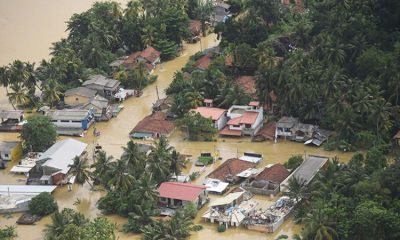
 News7 days ago
News7 days agoWeather disasters: Sri Lanka flooded by policy blunders, weak enforcement and environmental crime – Climate Expert
-
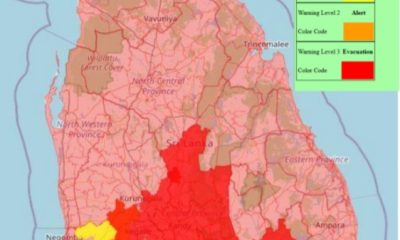
 Latest News7 days ago
Latest News7 days agoLevel I landslide RED warnings issued to the districts of Badulla, Colombo, Gampaha, Kalutara, Kandy, Kegalle, Kurnegala, Natale, Monaragala, Nuwara Eliya and Ratnapura
-
News4 days ago
Lunuwila tragedy not caused by those videoing Bell 212: SLAF
-
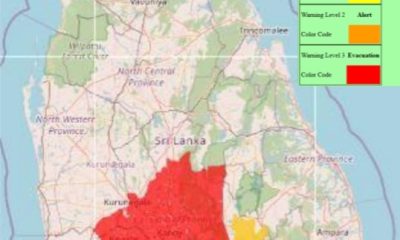
 News2 days ago
News2 days agoLevel III landslide early warning continue to be in force in the districts of Kandy, Kegalle, Kurunegala and Matale
-
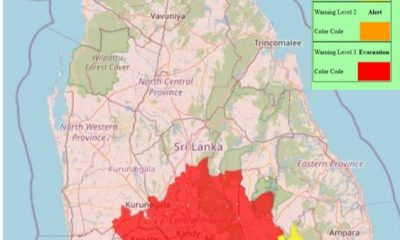
 Latest News5 days ago
Latest News5 days agoLevel III landslide early warnings issued to the districts of Badulla, Kandy, Kegalle, Kurunegala, Matale and Nuwara-Eliya
-

 Features5 days ago
Features5 days agoDitwah: An unusual cyclone
-

 Latest News5 days ago
Latest News5 days agoUpdated Payment Instructions for Disaster Relief Contributions
-

 Latest News6 days ago
Latest News6 days agoLandslide Early Warnings issued to the Districts of Badulla, Colombo, Gampaha, Kalutara, Kandy, Kegalle, Kurunegala, Matale, Moneragala, Nuwara Eliya and Ratnapura


